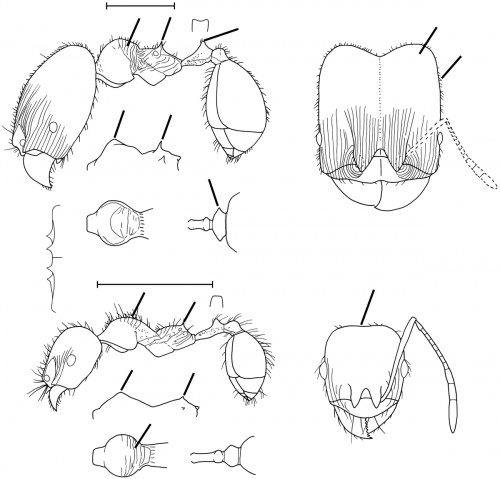Pheidole bakeri
| Pheidole bakeri | |
|---|---|

| |
| Scientific classification | |
| Kingdom: | Animalia |
| Phylum: | Arthropoda |
| Class: | Insecta |
| Order: | Hymenoptera |
| Family: | Formicidae |
| Subfamily: | Myrmicinae |
| Tribe: | Attini |
| Genus: | Pheidole |
| Species: | P. bakeri |
| Binomial name | |
| Pheidole bakeri Forel, 1912 | |
Nothing is known about the biology of bakeri.
Identification
See the description in the nomenclature section.
Keys including this Species
Distribution
Known only from Cuba (Havana and San Blas, Pinar del Rio). (Wilson 2003)
Latitudinal Distribution Pattern
Latitudinal Range: 22.149969° to 22.149969°.
| North Temperate |
North Subtropical |
Tropical | South Subtropical |
South Temperate |
- Source: AntMaps
Distribution based on Regional Taxon Lists
Neotropical Region: Cuba (type locality), Greater Antilles.
Distribution based on AntMaps
Distribution based on AntWeb specimens
Check data from AntWeb
Countries Occupied
| Number of countries occupied by this species based on AntWiki Regional Taxon Lists. In general, fewer countries occupied indicates a narrower range, while more countries indicates a more widespread species. |

|
Estimated Abundance
| Relative abundance based on number of AntMaps records per species (this species within the purple bar). Fewer records (to the left) indicates a less abundant/encountered species while more records (to the right) indicates more abundant/encountered species. |

|
Biology
Castes
Worker
Minor
Images from AntWeb

| |
| Syntype of Pheidole bakeri. Worker. Specimen code casent0908160. Photographer Will Ericson, uploaded by California Academy of Sciences. | Owned by MHNG, Geneva, Switzerland. |
Nomenclature
The following information is derived from Barry Bolton's Online Catalogue of the Ants of the World.
- bakeri. Pheidole bakeri Forel, 1912b: 82 (s.w.) CUBA. Subspecies of androsana: Wheeler, W.M. 1913b: 491. Revived status as species: Wilson, 2003: 660.
Unless otherwise noted the text for the remainder of this section is reported from the publication that includes the original description.
Description
From Wilson (2003): DIAGNOSIS Most similar to Pheidole androsana of the Bahamas, from which it differs principally by the smooth and shiny posterior half of the major’s head capsule and carinulate mesopleuron, as well as by its longer propodeal spines.
MEASUREMENTS (mm) Syntype major: HW 1.60, HL 1.90, SL (not measured), EL 0.22, PW 0.80. Syntype minor: HW 0.60, HL 0.64, SL 0.62, EL 0.12, PW 0.40.
COLOR Major: concolorous medium yellow with a slight reddish tinge, hence light “orange.”
Minor: concolorous medium yellow.
Figure. Upper: syntype, major (damaged specimen; outline of antenna drawn from specimen collected at San Blas, Pinar del Rio). Lower: syntype, minor. Scale bars = 1 mm.
Type Material
CUBA: Havana. Musee d'Histoire Naturelle Genève and Museum of Comparative Zoology - as reported in Wilson (2003)
Etymology
Eponymous. (Wilson 2003)
References
- Forel, A. 1912c. Einige interessante Ameisen des Deutschen Entomologischen Museums zu Berlin-Dahlem. Entomol. Mitt. 1: 81-83 (page 82, soldier, worker described)
- Wheeler, W. M. 1913b. The ants of Cuba. Bulletin of the Museum of Comparative Zoology 54: 477-505 (page 491, subspecies of androsana)
- Wilson, E. O. 2003. Pheidole in the New World: A dominant, hyperdiverse ant genus. Harvard University Press, Cambridge, MA. (page 660, Raised to species: new status)
References based on Global Ant Biodiversity Informatics
- Alayo D. P. 1974. Introduccion al estudio de los Himenopteros de Cuba. Superfamilia Formicoidea. Academia de Ciencias de Cuba. Instituto de Zoologia. Serie Biologica no.53: 58 pp. La Habana.
- Fontenla J. L., and J. Alfonso-Simonetti. 2018. Classification of Cuban ants (Hymenoptera: Formicidae) into functional groups. Poeyana Revista Cubana de Zoologia 506: 21-30.
- Forel A. 1912. Einige interessante Ameisen des Deutschen Entomologischen Museums zu Berlin-Dahlem. Entomol. Mitt. 1: 81-83.
- Kempf, W.W. 1972. Catalago abreviado das formigas da regiao Neotropical (Hym. Formicidae) Studia Entomologica 15(1-4).
- Mann W. M. 1920. Additions to the ant fauna of the West Indies and Central America. Bulletin of the American Museum of Natural History 42: 403-439.
- Morrison L. W. 1998. A review of Bahamian ant (Hymenoptera: Formicidae) biogeography. Journal of Biogeography 25: 561-571.
- Wheeler W. M. 1913. The ants of Cuba. Bulletin of the Museum of Comparative Zoology 54: 477-505.
- Wilson, E.O. 2003. Pheidole in the New World: A Dominant, Hyperdiverse Genus. Harvard University Press



